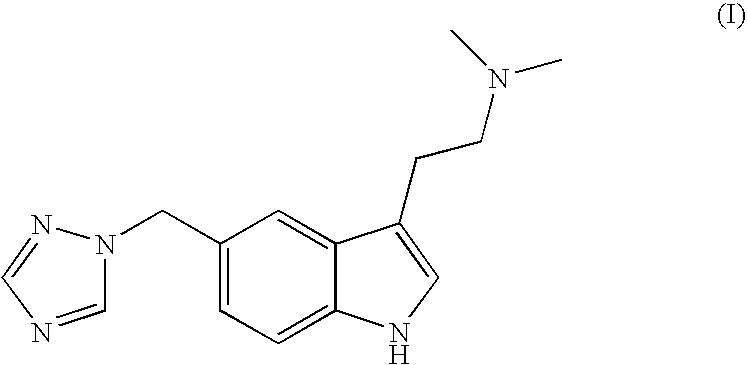Process for preparing a pharmaceutically active compound
a technology of pharmaceutically active compounds and process steps, applied in the field of process for preparing pharmaceutically active compounds, can solve the problems of high process cost, low overall yield, and inability to carry out the process at industrial scal
- Summary
- Abstract
- Description
- Claims
- Application Information
AI Technical Summary
Problems solved by technology
Method used
Image
Examples
examples of synthesis
Example 1
3-(2-Hydroxyethyl)-5-[1,2,4]triazol-1-ylmethyl-1H-indol-2-carboxylic acid
[0064]To a solution of 3 g (14.28 mmoles) of 4-(1,2,4-triazol-1-ylmethyl)phenylamine hydrochloride in 6 ml of water and 11.5 ml of concentrated HCl, cooled to 0° C., a solution of 1 g (14.5 mmoles) of sodium nitrite in 2 ml of water was added slowly, keeping the temperature below 0° C. The mixture was stirred at this temperature for 15 minutes. The diazonium salt solution was then added rapidly to a solution of 10.8 g (85.7 mmoles) of sodium sulphite in 21.5 ml of water precooled to 0° C. under nitrogen atmosphere. The red solution was stirred at 0° C. for 10 minutes and then left to reach 65° C. in 1 hour. It was stirred at 65° C. for 30 minutes, and 6 ml of concentrated HCl then added. The mixture was stirred at the same temperature under nitrogen atmosphere for 1 hour and then left to cool to room temperature. To this solution was added a solution of 22.8 mmoles of α-keto-δ-valerolactone(prepared by...
example 2
3-(2-Hydroxyethyl)-5-(1,2,4-triazol-1-ylmethyl)-1H-indol-2-carboxylic acid methyl ester
[0068]2.7 ml (42 mmoles) of methanesulphonic acid were added to a suspension de 6 g (21 mmoles) of the 3-(2-hydroxyethyl)-5-[1,2,4]triazol-1-ylmethyl-1H-indol-2-carboxylic acid in 120 ml of methanol. The mixture was left under stirring at reflux temperature for 3 hours. The solvent was evaporated to dryness under reduced pressure, the residue dissolved with 20 ml of a saturated bicarbonate solution and extracted 3 times with ethyl acetate. The combined organic phases were dried and evaporated to dryness, and the evaporated solid recrystallised from isopropyl alcohol / heptane to give 5.9 g (93%) of the title ester as a yellow crystalline solid.
[0069]M.p. 177.8-179.5° C.
[0070]IR (KBr): 1704, 3230 cm−1.
[0071]1H-NMR (200 MHz, DMSO-d6): 3.19 (m, 2H, CH2CH2OH); 3.58 (m, 2H, CH2CH2OH); 3.86 (s, 3H, CH3); 4.71 (t, J=5.2 Hz, 1H, OH); 5.45 (s, 2H, CH2-benz.); 7.22 (d, J=8, 4 Hz, 1H, ar); 7.37 (d, J=8.4 Hz, 1...
example 3
3-[4-(1,2,4-Triazol-1-ylmethyl)phenyl-hidrazono]tetrahydropyran-2-one
a. (4-[1,2,4]Triazol-1-ylmethylphenyl)hydrazine hydrochloride
[0073]To a solution of 1.5 g (7.1 mmoles) of 4-(1,2,4-triazol-1-ylmethyl)phenylamine hydrochloride in 3.75 ml of water and 6.3 ml of concentrated HCl, cooled to 0° C., was added slowly a solution of 0.5 g (7.2 mmoles) of sodium nitrite in 2.6 ml of water, keeping the temperature below 0° C. The mixture was stirred at this temperature for 15 minutes. Once this time had elapsed the solution of the diazonium salt was added rapidly to a solution of 5.37 g (42.6 mmoles) of sodium sulphite in 19 ml of water precooled to 0° C. under nitrogen atmosphere. The red solution was stirred at 0° C. for 10 minutes and then left to reach 65° C. in 1 hour. It was stirred at 65° C. for 30 minutes, and 5 ml of concentrated HCl were then added. The mixture was stirred at the same temperature under nitrogen atmosphere for 3 hours and then left to cool to room temperature.
b. 3-...
PUM
| Property | Measurement | Unit |
|---|---|---|
| temperature | aaaaa | aaaaa |
| temperature | aaaaa | aaaaa |
| temperature | aaaaa | aaaaa |
Abstract
Description
Claims
Application Information
 Login to View More
Login to View More - R&D
- Intellectual Property
- Life Sciences
- Materials
- Tech Scout
- Unparalleled Data Quality
- Higher Quality Content
- 60% Fewer Hallucinations
Browse by: Latest US Patents, China's latest patents, Technical Efficacy Thesaurus, Application Domain, Technology Topic, Popular Technical Reports.
© 2025 PatSnap. All rights reserved.Legal|Privacy policy|Modern Slavery Act Transparency Statement|Sitemap|About US| Contact US: help@patsnap.com



